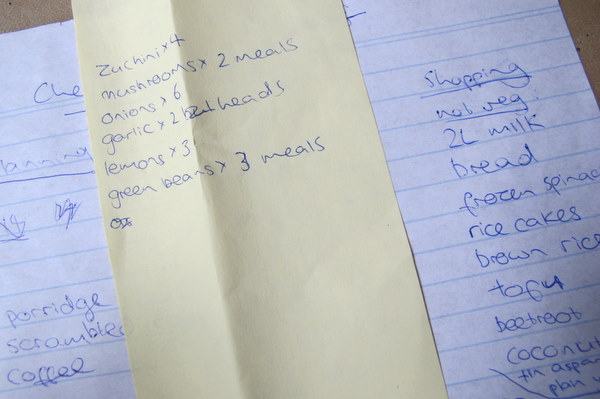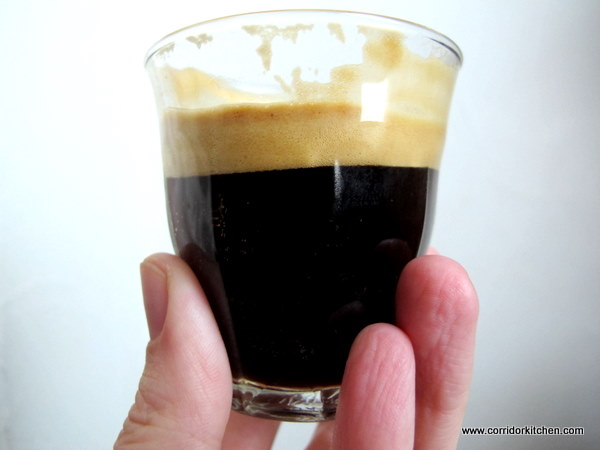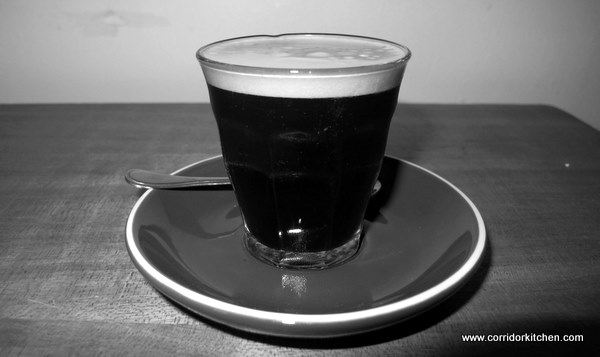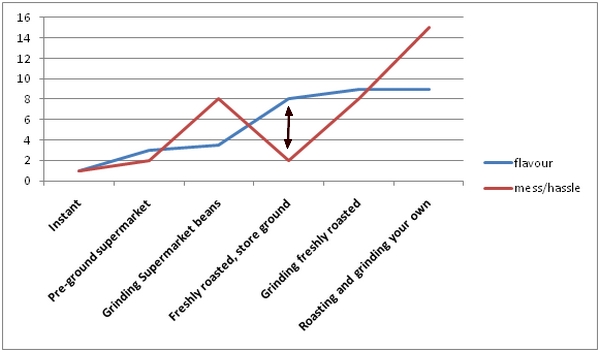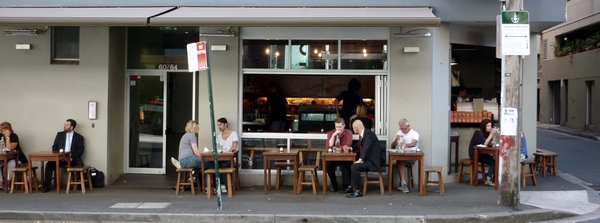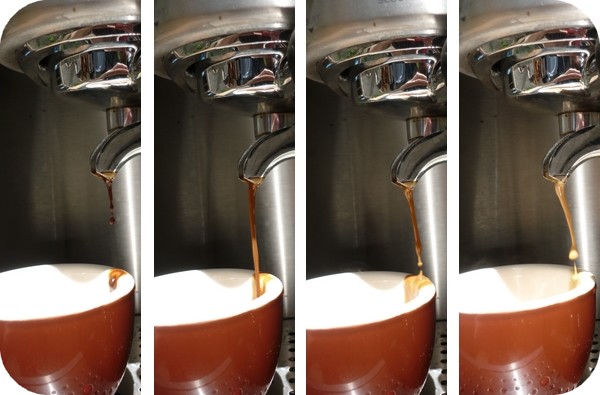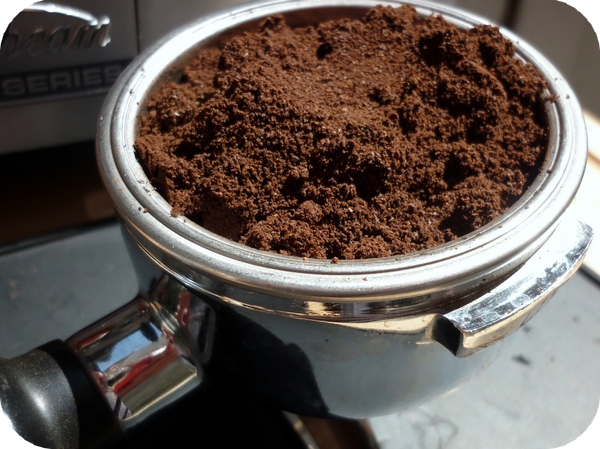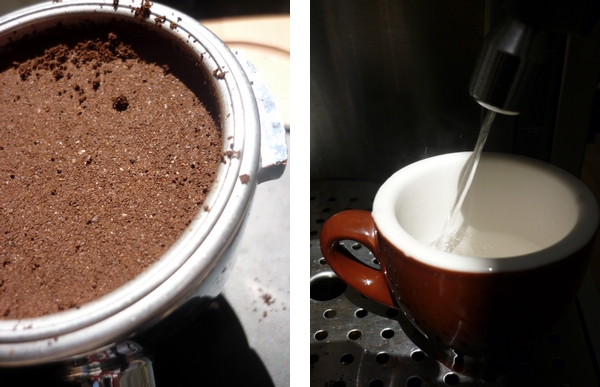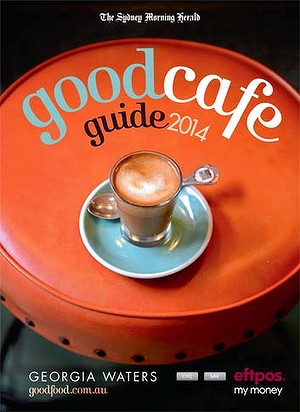About a month ago, we got talking about unsolicited PR emails, specifically, badly written, poorly targeted ones and how bloggers react to them. I asked for your take- your experience, what irks you, what you like, and what could improve this process for you. What follows are my 5 tips for PR companies when approaching bloggers.
1. Read the about page
Or any other page that might tell you whether the blogger will be remotely interested in what you’re pedalling. So many PR companies do not do this at all and it astounds me. There are many blogs that are ad free, don’t do sponsored posts or giveaways and state this clearly, sometimes multiple times. There is not point contacting someone with a policy like this, for example.
2. Read the blog!
Before you even think about firing off an email, spend some time looking at the kind of posts the blogger writes. Are there sponsored posts or product reviews? Do they write about an area related to your product? For example, I write a lot about coffee so I was offered a coffee machine to review. This was hardly a surprising thing for me to review. Look at the sidebars. Are there any ads? Do you think this is deliberate? Try and see where your promotion might be a good fit. If the answer is resounding ‘no’, let it lie.
3. Write a real email
You wouldn’t send the same cover letter out for every job, why would you send the same email to every blogger? You are pitching your product/promotion to the blogger, not he other way around. Don’t expect them to be grateful (although they may be) and don’t expect them to jump at the chance to run your promotion. Their blog is a project in which they are the writer, graphic designer, photographer, editor, account manager, etc etc. As such, may selective about the kind of promotions, if any, they run. They may also get tons of offers every day, so give them plenty of time to read and consider yours (no point emailing me about a promotion that needs to run next month, for example). And for god’s sake, get the blogger’s name, and the name of their blog, right. If I get one more PR email addressed to ‘Laura’, I’ll scream!
4. Write a concrete, concise proposal
In other words, be clear. What are you offering? Spell it out. Even minor league bloggers will get a few PR emails a month, and they are not likely to bother replying if they have no idea what’s on offer. Don’t write to a blogger asking for all their stats, especially without giving them a clear picture of what they’re signing up for. You know what your company’s policy is/what promotion you’re offering, put it in the very first email. It may be something like ‘we pay $20 for each text-based ad you run for a month for any blogs with 1000+ pageviews/month’ or ‘we would like you to review our new flavour of chocolate and can send you 1kg of chocolate as payment’.
Having this information, the blogger immediately knows whether or not your promotion will be a good fit for them. And having read their blog, you’ll know this too. There’s no point in writing ‘we offer text based ads to enhance your online profile and monetise your blog’. What in the hell does that even mean? How many emails will it take me to find out?
5. Be flexible
By approaching bloggers like a real person, you need to be prepared for a real answer. If there’s any scope at all for you to be flexible with your proposal, do so. Sometimes a blogger might have another way of looking at what you’re doing that may be of benefit. For example, you might offer to give them a free product, but they might prefer to give it away to their readers. You might ask for a review, they may prefer to use you product in a recipe.
Even with these tips in mind, you need to be prepared to be turned down. But hopefully you’ll get a reply, perhaps even one that’s speedy and polite, and you can cross that blog off your list.
What are your tips for PR reps when approaching bloggers?
So today I received yet another unsolicited email from a media/PR company. They love bloggers. They love my blog. So do the companies they represent. They would like to give me some money to do a/some sponsored posts/s.
I’m interested in what y’all think about unsolicited PR/media emails. I get a lot of these, and they all run along the same lines.

If only PR companies would write to me on oldey timey typewriters. At least it'd be something a bit different...
Generally it’s a form email with your name and blog name inserted. It offers a vague proposal – sponsored posts or adspace at unspecified figures which will only be revealed once you’ve signed up/shown some interest…
Subject: we love you blog!
Dear (name),
We love (name of blog), perhaps for some reason that makes no sense at all or perhaps for I can’t be bothered to think of an example. My company works with bloggers and companies to make awesomeness. We will give you some money and our client (who totes loves your blog btw) will give you an unspecified amount of money to do an unspecified thing. How exciting!!!
I can’t tell you who any of these companies are or which one/s love your blog. How about you look at our website for testimonials and even more vague information? Cool.
We love bloggers. We love them because we know we can go to them with vague claims of representing brands and they’ll jump at the chance to sell us cheap adspace. We couldn’t pull this shit with ‘real’ media, that’s for sure.
Please respond to this email if you want to know more, at which point I will ask for all your personal information and get you to sign a contract before you see a penny.
Best,
(company)
I’m interested in what bloggers think about this practice. To me, there’s a spectrum of how these companies approach you. The relevance of their proposal is very much determined by how much time they’ve spent looking at your blog and whether they’ve considered your subject, audience, and so forth.
What do you think?
Are you interested in these kinds of promotions?
Have you had any good/bad experiences with these kind of promotions?
Do you have ‘rates’ as such?
And, most importantly:
What would improve this process for you?
Do you have any tips for bloggers?
Do you have any tips for PR/media companies?
I’d love to know what you think.
I don’t know about you, but I don’t plan on dying of some kind of vitamin or mineral deficiency in the next week. Sure, I could complete The $35 Challenge on nothing but mee goreng, oranges and beer, but that’s not really a sensible way to play it, and I’m nothing if not sensible. Below are my top ten tips for menu planning, your money and sanity saver. And not just during The $35 Challenge.
1. Take stock of your pantry
I just did and there is waaaaaaaaaaaay more stuff in there than I realized. 4 kinds of rice, three shapes of pasta, tins of tomatos, legumes, beetroot, pineapple, tahini, enough condiments and sauces to open a deli, at least 18 different spices and various baking ingredients – sugars, flours, cocoa, almond meal, rosewater, vanilla pods…the list goes on. Any and all of these things can form the starting point for a menu, so take a quick look in your cupboards.
2. Take stock of your fridge/freezer
Before I write a menu, I so often make the mistake of not checking what’s in the fridge or freezer. More condiments. A dozen eggs. Half a kilo of greek yogurt. Five kinds of cheese? All that’s really needed is a shitload of veggies and some meat and I should be able to sort out at least 5 main meals.
3. A menu is just a list
Here’s how you do it: write down every meal you’re going to eat. Then write down every ingredient you don’t already have which is in that meal. Then add anything else to your list that’s not technically part of a meal – snacks, fruit, cleaning products etc.
In fact, why not just write down everything you ate last week as a starting point? Maybe you eat all your lunches out and have toast for breakfast every day. In that case, a menu would just cover dinners. Maybe you order takeaway once a week? This doesn’t have to change, just pencil it in.Suddenly, your shopping list is done.
4. Plan regularly – about as often as you shop
I prefer to shop once a week, so I write a menu once a week. This is a trick I learned from my mum and it’s what has always worked for me. I find fortnightly shops mean I end up with stuff going off or getting forgotten about, and shopping every few days means I end up making a lot more impulse purchases. Find what works for you and stick to it.
5. Be realistic
This is key. You need to be realistic about what you’ll cook, how often you’ll cook and what you’ll actually eat. There are a few dishes that crop up again and again on my menus but never get made because they’re either too boring (chick pea stew anyone?) or too much effort come 6:00pm on a Thursday evening (yes, I will stuff and roast an entire chicken on a week night, without a recipe). Make it easy on yourself.
6. Consider what’s in season
Taste.com.au publishes a monthly list of all the fruit and veg in season. It’s often a good idea to have a look at something like this before you decide what to cook as it will give you some idea of what will be available, tasty and cheap.
7. Be flexible
Maybe you thought you’d serve grilled fish with mashed potato and green beans today – that’s what’s on your menu. But when you get to the supermarket, asparagus and pumpkin are on special, so you change your plans accordingly. Flexibility should also apply to when you want to serve something- just because your menu says taco Tuesday doesn’t mean you can’t switch it to Wednesday ‘cause your plans have changed. In my case, I don’t allocate specific days on my menu – my menu is just a list of meals in no particular order.
8. Throw in a few wildcards
Try and prepare one new dish a week or, failing that, try one new ingredient. Or, use an ingredient in a new way. This will stop your taste buds getting bored. Until recently I’d never really cooked steak or fish (I was vego for 10 years). A few weeks ago I finally tried pineapple as a savoury ingredient when I made this pineapple salsa. Try new things whenever there’s time or the mood takes you.
9. Stop asking yourself ‘what do I feel like eating today’?
If your menu is realistic, flexible and varied, you won’t need to ask yourself this question each day or for each new meal. By taking choice out of the equation on a case-by case basis, you’ve also taken out the work. Once menu planning is a habit, you’ll never look back.
10. Make your final weekly meal ‘odds ‘n ends’
Chances are no matter how meticulous your planning, you’re going to have a few things left at the end of the week. Maybe you didn’t make one of your meals or maybe you just ended up with too much of something. Either way, you can probably whip something up with what you’ve got. Then you’re all ready for your next menu.
It’s not too late to support the $35 Challenge. During Anti-Poverty Week, from October 16-22, participants have $5 a day to spend on food. By experiencing poverty for just 7 days, we come to a better understanding of the realities and stresses of those living in poverty. By blogging or tweeting this experience, we can raise awareness of an issue so often swept under the rug. And by donating the remainder of the money we would usually spend on food to OzHarvest, we can make a real difference.
A while ago while visiting Don Campos in Alexandria, I noticed a sparkling long black on their menu. I’d always wondered what it was and how it was made, but of course I didn’t do anything as obvious as to ask what it was or better yet, order it. It remained an elusive espresso mystery.
I’d pretty much forgotten about it until I visited the Cupping Room a couple of weeks ago. I asked Todd who was hosting the session what it is and he said it basically a frozen latte glass containing a ristretto topped up with iced mineral water. It’s a cooling summer coffee for those of us who aren’t so fussed on the creamy, milky or sweet iced coffees you usually come across.
I know it’s not warm here right now but it must be somewhere so I decided I’d post it again before I forget. Todd recommended a piccolo/short black glass rather than a latte glass so that’s what I used.
The flavour was mild and refreshing and actually, it makes a lot of sense when you think about it when I think back to the terrible espressos I had in Argentina and how they always came with a tiny glass of mineral water to soften the blow. The sparkling long black is no longer on Campos’ official menu so ordering it is likely to elicit some raised barista brows…
embedded by Embedded Video
Sparkling Long Black
An espresso machine
A frozen cup/glass
Freshly ground coffee
Sparkling mineral water, chilled
Run a shot of about 15 ml of espresso into the cup or glass. Top with chilled mineral water. Serve.
So, is there a drink you’ve been dying to try?
I have a shameful secret to reveal. I don’t grind my own coffee.
Being a barista (well, not right now), this has sometimes led to a questioning of my coffee expertise, something along the lines of ‘Well, if you can’t taste the difference, I guess it’s no big deal.’ Oh, clever, I see what you did there. A little passive-aggressive jibe not at only my expertise, but at my actual sense of taste! Nice one. Then there’s the more overt ‘how can anyone who doesn’t grind their own beans know anything about coffee?’

Actually, I know great deal about coffee, definitely more than nothing. And it is this knowledge, along with my own personal circumstances, that has led me to drink it the way I do. First world problems, eh? Here are the 4 steps of reasoning that lead me to believe a grinder is not for me.
1. The ‘scale of flavour’ is a myth
Firstly, I call into question that there is one perfect coffee bean out there that, when perfectly ground and extracted, will yield perfect results for everyone. It has been proven that the majority of people like a light, caramel roast and there’s also a chunk that prefers a dark roast, so that in itself blows that idea out of the water. But let’s take a look at this imaginary scale anyway:
The perfectionist’s scale:
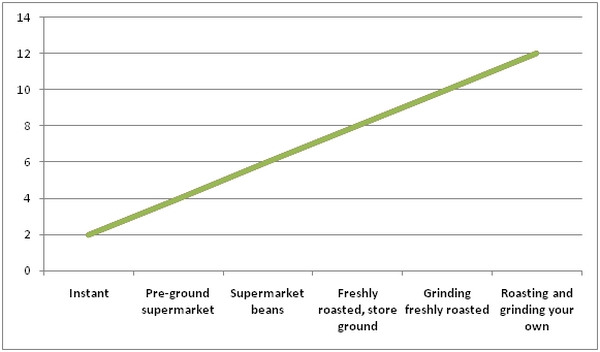
Now I have a billion issues with this graph. First, if this were the scale, how would the coffee machine factor in? What if you used French press, a $100 espresso machine, a $1000 espresso machine, stovetop, hot water, cold water extraction, syphon… the list goes on. What about skill? What about mistakes? What about how much coffee you have to throw out whenever you grind it wrong? There are too many variables, so let’s just look at two – flavour and mess/hassle.
2. Flavour vs. Effort. That’s my scale.
In this diagram, the blue line represents flavour and the red line represents mess/hassle.
Notice I’ve given pre-ground supermarket coffee a 2 for flavour, store-ground boutique coffee an 8 for flavour, and boutique beans a 9. So you’d think the beans are the natural choice. But not so, because grinding beans has a mess/hassle score of 8 which is quite high, where getting a store to grind it with a commercial grinder is a 2. What I’m looking for is a large gap between mess/hassle and flavour, with flavour at the top. Thus, store ground boutique coffee has a score of 4 (8/2) and boutique beans get 1.125 (9/8). That’s my reasoning.
3. I have skills, I don’t need gadgets.
The truth is I don’t need a graph, but I drew it to make a point- there is not an absolute value for flavour. There are standards. There are better methods and worse methods. But there is also what works for you. At the end of the day, I don’t own a grinder because it just isn’t that important to me, and I’m drinking much nicer coffee than a lot of people who do. It’s my theory that just as a poor tradesman blames her tools, a poorly skilled one buys fancy tools to make up for that lack of skill. And it doesn’t work.
4. Other factors
Of course there are other factors. The fact that I live in inner-city Sydney, surrounded by coffee roasters and great cafés is one of them. The fact that I am a trained barista is another. A kitchen the size of a built-in wardrobe is another – there’s no space for a grinder. And there’s a whole other issue as well, which is that the more complex the method, the more crap you are talked into buying, and buying stuff is not one of my favourite activities. But either way, my graph still stands. Because science.
What about you? Have you come up against any first-world-type judgements lately? Maybe you didn’t deglaze a pan properly? Maybe you don’t eat organic, or don’t breast-feed your child? Tell me about an occasion your common-sense reasoning was undermined by hipsters. Sock it to me, chums.
We’ve all been there. Eagerly awaiting that fist sip of coffee only to find a disappointing brew that can only be described as ‘that’s not what I ordered.’ It’s all too easy to criticise, saying you asked for ‘extra hot’ or ‘strong’ or ‘not too much froth’ but these are subjective terms. Wouldn’t it be lovely if someone would give you a user’s manual for the wank-fest that is coffee these days? Well, somebody has. Here are the five simple rules to get not only the correct coffee, but the best.
1. If you don’t want sugar, never, ever ask for ‘no sugar’.
I know many people do this to pre-empt the irritating, automated query that comes free with any takeaway coffee almost immediately after you’ve placed your order: ‘any sugars’? However, in a crowded, noisy coffee shop, no matter how good the barista’s ears, ‘no sugar’ almost always sounds like ‘one sugar’ and that’s what you will get, which will annoy you no end.
The reason every customer gets asked ‘any sugars?’ is to save us all from that all too common moment after a customer receives their small cap and asks ‘did you put the sugar in?’ and then the barista has to take the coffee, open it, add the required number of sugars, stir and re-lid it. This makes no sense at all because HOW ON EARTH WOULD THEY KNOW HOW MUCH SUGAR TO PUT IN?! So undergo the annoying automated query. You are saving, not wasting time.
2. Don’t leave the coffee shop, either literally or mentally.
It’s a bad idea to talk on your phone, listen to your mp3 player or just not listen for your order. It’s an even worse idea to expect to be served while you’re actually talking on your phone. This ensures grumpy service and its likely you’ll end up with the wrong coffee.
Although the number of people who take the wrong coffee is pretty miniscule it is hugely annoying, not only for the person who does it but for the customer who has to wait for a new coffee and for the barista who has to make their coffee all over again. Listening out for your order assures this won’t happen, as does keeping an eye on who ordered before you. Chances are when they collect their coffee, you’re next.
3. Know your order
It sounds so obvious, but you’d be surprised how many people don’t know what they order. I once had a guy come in and order three coffees: a macchiato and two lattes. What he actually wanted was a mug of cappuccino and a mug of long black. He didn’t even know how MANY coffees he wanted.
In a lot of cafés, the staff know all their regular customers’ orders. But if there is ever a new staff member who doesn’t know your order or you change cafés, you need to know what it is you order. So when someone asks you ‘what would you like today?’ it is not at all helpful to say ‘She/he knows’ or ‘my usual’ if you have never in your life seen the person standing in front of you.
4. Expect the barista to know what the coffee they just made is. Don’t expect them to know whose it is.
Once your coffee is made, if the barista yells out ‘large caramel cappuccino with two equals’ and that’s what you ordered, there’s not much point in asking ‘is that my coffee?’. The barista, in a flurry of making 25 coffees at once, will have no idea, he/she will only know what the coffee is as he/she most likely did not take your order. If you’ve been paying attention, you’ll notice the person who ordered before you just grabbed their coffee so it must be yours. Or you might notice you are the only person left in the coffee shop. Or you might notice that your order is so incredibly unique that no one else could have ever dreamed it up. A large-strong-half-skim-half-full-cream-Chai-latte-no-cinnamon-on-top-extra-hot, for example. That’s yours for sure.
5. Want stronger coffee? Reduce milk, don’t add shots.
The cheapest way to strengthen coffee is to reduce the amount of milk, not add more coffee shots. This little-known secret also inadvertently leads the barista to take your request more seriously. Why is this? Well, it’s because by asking for a small ¾ full cappuccino instead of a double shot small cappuccino, you are being particular and your order is memorable. This means that the barista knows if they get your coffee wrong you’ll return it, and so, to avoid this, they’ll make exactly what you asked for. You’ll also get their full attention so there’s less chance of mistakes.
So there you go. Truly, it is knowing how not to order your coffee that is the key to a) receiving what you ordered and b) it tasting delicious. Why? Well, a) because the barista will have a clear understanding of what you want and b) they will go out of their way to give it to you.
I bet you’ve all got something to say about café etiquette. What really irks you, chums?
Disclaimer:
I want to preface this post by saying that there are a million web pages and forums out there that will show you how to make ‘the perfect espresso’. Also, there is much debate about coffee generally, from cafes that won’t serve espresso over ice to those who refer to it as ‘expresso’ to those that serve the completely made up caramel machiatto.
This post bears no relevance to any of that. What I want to do here is show you, the humble domestic coffee machine owner, how to get the best out of your machine. Note that your machine is not my machine and that my methods are not perfect for everyone. This post comes from a tiny, low-tech corridor kitchen and a place of extreme laziness, but also from a girl who cannot live without coffee. Ever.
Skill over gadgetry – A poor tradesman blames his tools
Believe me when I say that it really doesn’t matter what kind of machine you have unless you are drinking ristrettos and short blacks every day (which I am) and grinding your own beans fresh (which I’m not – more on that in a later post). For example, my brother owns a hand-me-down machine that retails now for about $50-$100 and I can get a decent coffee out of it. No worries mate.
Five tips for perfect espresso
To that end, here are my top tips for extracting the best from domestic coffee machines, no matter their quality.
- Whether you grind your beans or buy them ground, make sure they’re ground fine enough. Domestic machines generally require quite a fine grind to ensure a good, even pour.
- To start with, measure and time your shots. 20-30 seconds (ideally 25) for a 30 ml single shot is a good guide.
- Clean your machine regularly, descaling and replacing the water filter as often as needed (your could use filtered water but really? Do you wanna be THAT guy?).
- Use your machine regularly and run some water through it before and after making yourself a coffee.
- Don’t be precious- throw away bitter shots, poorly ground coffee and old beans. This is how your favourite cafe delivers your that perfect cup. Practice and waste are mandatory.
The perfect shot
As I said, you’re aiming for a 25 second, 30ml shot. But more than that, you are aiming for a shot that tastes right to you. Coffee is analogous to wine these days in terms of wankery but I will say this – you don’t want a watery taste nor a very bitter one. This takes a while to work out so even if you’re making cappuccinos or lattes, take a sip of the shot before you add the milk and eventually you’ll get a feel for what you’re after.
It’s visually quite easy to tell when a shot is done regardless of the pressure of the machine. In addition to the length and time of the shot, there is a distinct change in colour that signals the shot is nearly done – from deep brown to a lighter brown. About halfway through the shot, a creamy layer called the crema starts to form on top of the shot which should remain intact for a couple of minutes. When the crema coming out of the machine starts to turn white you’ve gone a touch too far.
Depending on the size of the basket, you need to use around two scoops/tablespoons of coffee and tamp firmly in an even, downward twisting motion. If the shot is too slow tamp softer/grind coarser and if it’s too fast do the opposite. And remember you can always buy different coffee if you don’t like the results you’re getting. Shop around.
About me
 Sharing easy recipes, hunting down the best coffee. Honest accounts, nothing too serious. Read more...
Sharing easy recipes, hunting down the best coffee. Honest accounts, nothing too serious. Read more...Recent Posts
- Aerpress means no more shit #travelcoffee and #workcoffee
- Why I write and four ace bloggers who do it better
- The five best things I ate in London
- Shoreditch is awesome, airports are not
- I quit sugar? Do I bollocks.
- Cubao Street Food, Alexandria
- The Reformatory Caffeine Lab, Surry Hills
- Brewtown Newtown
- Stay caffeinated over Christmas
- Gumption by Coffee Alchemy, Sydney CBD
Popular posts this month…
 Sparkling Long Black posted on May 10, 2011
Sparkling Long Black posted on May 10, 2011  Review – Philips Saeco Intelia posted on January 10, 2012
Review – Philips Saeco Intelia posted on January 10, 2012  Kosher Whole Orange Cake posted on July 5, 2011
Kosher Whole Orange Cake posted on July 5, 2011  Cheat’s Dulce de Leche posted on January 7, 2011
Cheat’s Dulce de Leche posted on January 7, 2011 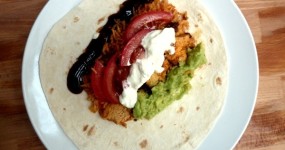 The quest for Mex part 2 – Feisty Chicken Burritos posted on December 21, 2010
The quest for Mex part 2 – Feisty Chicken Burritos posted on December 21, 2010  Lemonade Scones and family recipes posted on February 25, 2011
Lemonade Scones and family recipes posted on February 25, 2011  Café Review – Petty Cash Cafe, Marrickville posted on May 31, 2011
Café Review – Petty Cash Cafe, Marrickville posted on May 31, 2011  Sri Lankan Spinach with Coconut posted on December 10, 2010
Sri Lankan Spinach with Coconut posted on December 10, 2010
Disclaimer:
All opinions in this blog are mine, an everyday, real-life person. I do not accept payment for reviews and nor do I write sponsored posts. I do not endorse the content of the comments herein.


